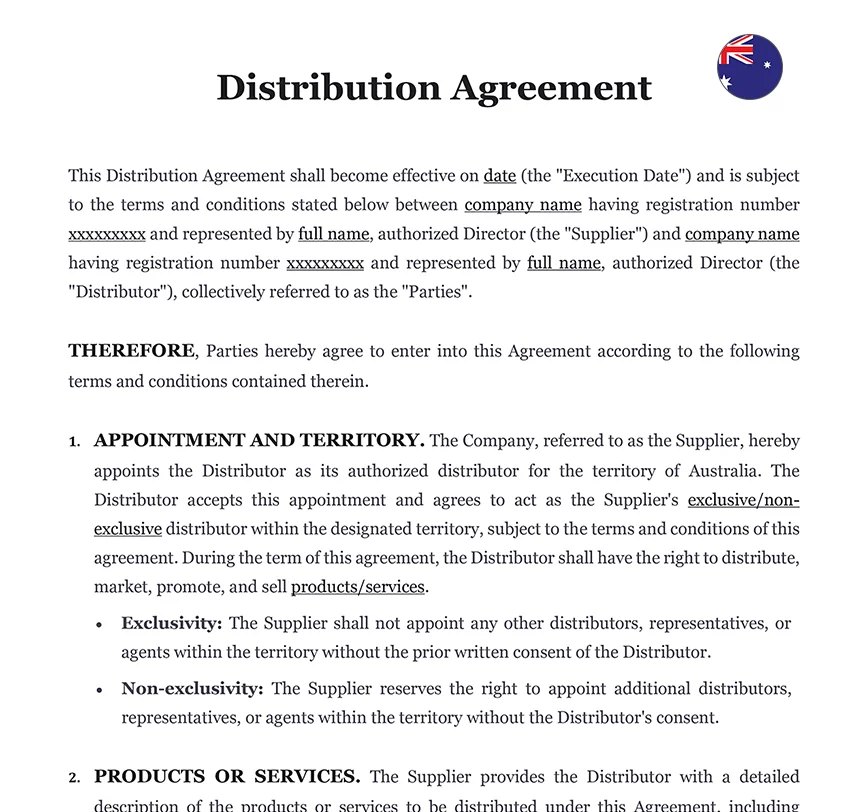Understanding Product Distribution Partnerships
A Distribution Agreement is the cornerstone of any product distribution partnership. This legally binding document outlines the terms and conditions under which a distributor is authorized to sell and distribute your products. Whether you are a manufacturer seeking to expand your market or a distributor looking to partner with a new supplier, the Distribution Agreement is essential for defining roles, responsibilities, and expectations.
Key Components of a Distribution Agreement
A Distribution Agreement typically includes several key components that establish the framework for the partnership:
1. Territory: Define the geographic area where the distributor is authorized to sell your products. This can range from a specific region to an entire country.
2. Exclusivity: Determine whether the distributor will have exclusive rights to sell your products within the specified territory or if you will retain the right to appoint additional distributors.
3. Sales Targets: Set clear sales targets that the distributor is expected to meet. These targets help ensure that both parties are aligned in their goals and provide a basis for evaluating the partnership’s success.
These components are crucial for creating a solid foundation for the partnership. For more on establishing clear terms in business agreements, our article on Drafting Contracts with Suppliers in Australia offers insights into the importance of clearly defined obligations and expectations.
Negotiating Terms and Conditions
Negotiating the terms of a Distribution Agreement requires careful consideration of both parties’ interests.
1. Pricing and Payment Terms: Agree on the pricing structure for the products, including any discounts or rebates. Payment terms should also be clearly defined, including due dates and acceptable payment methods.
2. Marketing and Promotion: Determine the distributor’s responsibilities for marketing and promoting the products. This might include advertising, trade shows, and other promotional activities.
3. Inventory Management: Specify the distributor’s obligations regarding inventory levels, including minimum stock requirements and procedures for handling returns or defective products.
Legal Compliance and Obligations
Ensuring legal compliance is critical when forming a distribution partnership.
1. Regulatory Compliance: The Distribution Agreement should include provisions that require the distributor to comply with all applicable laws and regulations in the territory where they operate. This is particularly important in industries with strict regulatory requirements, such as pharmaceuticals or electronics.
2. Product Liability: Clarify the responsibilities of each party in the event of a product liability claim. This includes ensuring that the products meet all relevant safety standards and that both parties have adequate insurance coverage.
3. Intellectual Property Rights: Protect your brand by clearly defining the distributor’s rights to use your trademarks, logos, and other intellectual property. The agreement should also include provisions for protecting confidential information.
Legal compliance is a complex area that requires careful attention to detail. For more on protecting intellectual property and confidentiality, our article on Using NDAs to Safeguard Business Secrets in Australia provides valuable insights into using Non-disclosure Agreements to protect sensitive business information.
Managing Dispute Resolution
No partnership is immune to disputes, so it’s important to include a clear dispute resolution mechanism in the Distribution Agreement.
| ➤ Arbitration and Mediation: Consider including arbitration or mediation clauses in the agreement as a means of resolving disputes without resorting to litigation. These methods can save time and money and help preserve the business relationship |
| ➤ Governing Law: Specify the governing law that will apply to the agreement. This is particularly important if the distributor operates in a different country with different legal systems. |
| ➤ Termination Clauses: Include clear terms for terminating the agreement, whether for cause or without cause. This ensures that both parties understand their rights and obligations if the partnership needs to be ended. |











